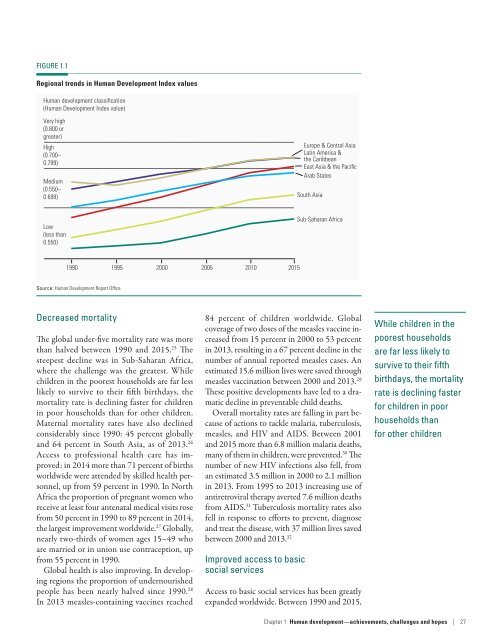Human Development Report 2016
6Tyccfrzw
6Tyccfrzw
You also want an ePaper? Increase the reach of your titles
YUMPU automatically turns print PDFs into web optimized ePapers that Google loves.
FIGURE 1.1<br />
Regional trends in <strong>Human</strong> <strong>Development</strong> Index values<br />
<strong>Human</strong> development classification<br />
(<strong>Human</strong> <strong>Development</strong> Index value)<br />
Very high<br />
(0.800 or<br />
greater)<br />
High<br />
(0.700–<br />
0.799)<br />
Medium<br />
(0.550–<br />
0.699)<br />
Europe & Central Asia<br />
Latin America &<br />
the Caribbean<br />
East Asia & the Pacific<br />
Arab States<br />
South Asia<br />
Low<br />
(less than<br />
0.550)<br />
Sub-Saharan Africa<br />
1990 1995 2000 2005 2010 2015<br />
Source: <strong>Human</strong> <strong>Development</strong> <strong>Report</strong> Office.<br />
Decreased mortality<br />
The global under-five mortality rate was more<br />
than halved between 1990 and 2015. 25 The<br />
steepest decline was in Sub- Saharan Africa,<br />
where the challenge was the greatest. While<br />
children in the poorest households are far less<br />
likely to survive to their fifth birthdays, the<br />
mortality rate is declining faster for children<br />
in poor households than for other children.<br />
Maternal mortality rates have also declined<br />
considerably since 1990: 45 percent globally<br />
and 64 percent in South Asia, as of 2013. 26<br />
Access to professional health care has improved:<br />
in 2014 more than 71 percent of births<br />
worldwide were attended by skilled health personnel,<br />
up from 59 percent in 1990. In North<br />
Africa the proportion of pregnant women who<br />
receive at least four antenatal medical visits rose<br />
from 50 percent in 1990 to 89 percent in 2014,<br />
the largest improvement worldwide. 27 Globally,<br />
nearly two-thirds of women ages 15–49 who<br />
are married or in union use contraception, up<br />
from 55 percent in 1990.<br />
Global health is also improving. In developing<br />
regions the proportion of undernourished<br />
people has been nearly halved since 1990. 28<br />
In 2013 measles-containing vaccines reached<br />
84 percent of children worldwide. Global<br />
coverage of two doses of the measles vaccine increased<br />
from 15 percent in 2000 to 53 percent<br />
in 2013, resulting in a 67 percent decline in the<br />
number of annual reported measles cases. An<br />
estimated 15.6 million lives were saved through<br />
measles vaccination between 2000 and 2013. 29<br />
These positive developments have led to a dramatic<br />
decline in preventable child deaths.<br />
Overall mortality rates are falling in part because<br />
of actions to tackle malaria, tuberculosis,<br />
measles, and HIV and AIDS. Between 2001<br />
and 2015 more than 6.8 million malaria deaths,<br />
many of them in children, were prevented. 30 The<br />
number of new HIV infections also fell, from<br />
an estimated 3.5 million in 2000 to 2.1 million<br />
in 2013. From 1995 to 2013 increasing use of<br />
antiretroviral therapy averted 7.6 million deaths<br />
from AIDS. 31 Tuberculosis mortality rates also<br />
fell in response to efforts to prevent, diagnose<br />
and treat the disease, with 37 million lives saved<br />
between 2000 and 2013. 32<br />
Improved access to basic<br />
social services<br />
Access to basic social services has been greatly<br />
expanded worldwide. Between 1990 and 2015,<br />
While children in the<br />
poorest households<br />
are far less likely to<br />
survive to their fifth<br />
birthdays, the mortality<br />
rate is declining faster<br />
for children in poor<br />
households than<br />
for other children<br />
Chapter 1 <strong>Human</strong> development — achievements, challenges and hopes | 27
















